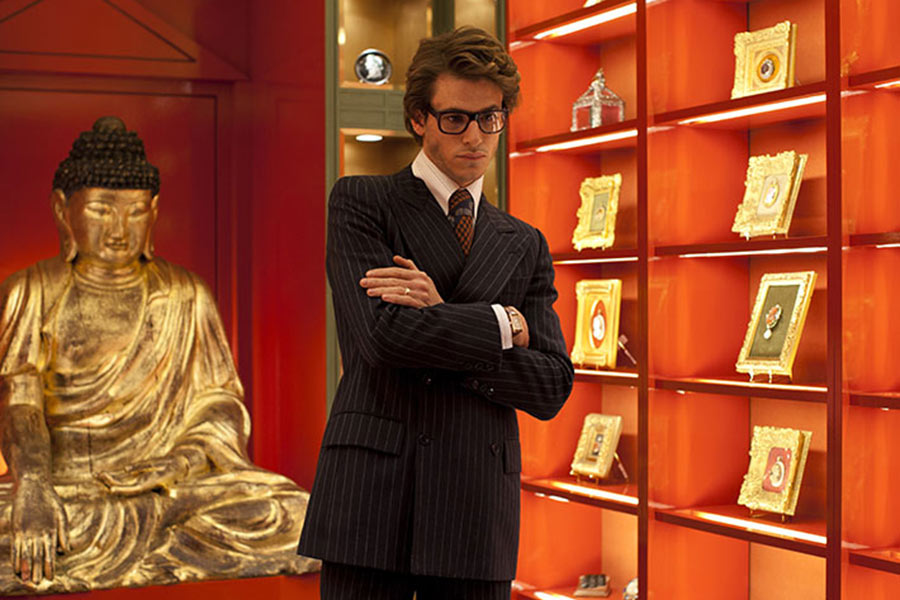Two French films, one by a gay director and the other about a gay designer are opening this weekend at Ritz Theaters.
The second feature film about Yves Saint Laurent in as many years, “Saint Laurent” is not a hagiography, despite its title. Rather than present the trendsetting fashion designer’s life from childhood to death (as Jalil Lespert’s uneven film “Yves Saint Laurent” did last year), director and co-writer Betrand Bonello’s biopic focuses mainly on the period of the late 1960s-early ‘70s when Laurent (Gaspard Ulliel) was at the height of his fame. The film toggles between various years, which makes this drama more of a patchwork chronology than a proper biography. The narrative approach actually dilutes the drama because Bonello emphasizes mood over plot, giving the film a lush, velvety feel rather than emotion.
As such, “Saint Laurent” is best when he immerses viewers in an aspect of its subject’s life. An early scene in the designer’s atelier, where his seamstresses are fitting clothes, is sublime; it captures the detail of the work and the genius of Laurent’s style. Likewise, a pair of episodes set in discothèques where Laurent spots and desires the model Betty Catroux (Aymeline Valade), or flirts with the dangerously sexy Jacques de Bascher (Louis Garrel), are terrific. When Bonello slowly pans back and forth across a crowded dance floor between the two men, he raises the erotic frisson between them. Even a scene where Pierre Bergé (Jérémie Renier), Laurent’s partner in both work and life, conducts a business meeting with an American executive (Brady Corbet) percolates with drama.
However, too much of “Saint Laurent” is all style and no substance. There are moments where Laurent talks about his influences — Marlene Dietrich, Mondrian and Marrakesh — or mentions having youth, beauty and wealth, but they are not especially illuminating. The film shows Laurent’s lavish lifestyle, replete with objets d’art he and Bergé collect, but these symbols of divine decadence — plates, a giant Buddha, multiple dogs — are meaningless, empty. His fame and influence are better presented in a letter Laurent receives from Andy Warhol or a scene of reporters discussing the designer’s obituary.
That said, the clothes are fabulous. Arguably the best scene in the film is a fitting Laurent has with a client, Mme Duzer (Valeria Bruni Tedeschi). As she wears a suit he designed, he slowly makes her more beautiful, changing her belt, taking her hair down and molding her to her outfit. The runway scenes are also fantastic, and Bonello creates multiple panels — like a Mondrian painting — for one sequence to present the fashion show from various angles. The music, a mix of pop tunes from the era, is effective for creating a real sense of feeling for the time while also commenting on the action.
Clocking in at 150 minutes, “Saint Laurent” is too long not to be a more thorough investigation of its subject’s life. Much of the film is given over to Laurent losing his grip on reality, something his mother (Dominique Sanda) observes, but which is also conveyed by Bonello in magical-realist scenes featuring Laurent seeing snakes in his bed.
When Laurent, in a state of hallucination, almost kills Bergé, the latter moves out. But so little is shown of their relationship together that this event has no real impact. Other than a curious sex scene between them, Laurent and Bergé hardly display affection or talk much to one another. In contrast, there are plenty of scenes depicting Laurent’s affair with de Bascher, which includes some decadent moments, ranging from a naughty sex party to a scene where the two men pass pills to each other through kisses, unaware that Laurent’s dog, Moujik, is ingesting the drugs as well.
Bonello makes other strange choices that also fail to pay off. A scene featuring a model and a nude woman discussing Laurent is intriguing, but it goes nowhere. The film also jumps ahead in time during its last third to show Laurent in 1989 (where he is played by Helmut Berger). These scenes feel very out of sync with the rest of the film, failing to generate any poignancy or sympathy for a character who is at times seen visibly struggling with anxiety and torment of having to create a new and exciting fashion line each season.
To his credit, Bonello does coax an outstanding performance by Ulliel. The actor, who is a spokesmodel for the fragrance Bleu de Chanel, channels Laurent convincingly when he eyes a model as he dresses her. He expresses Laurent’s despair well, but is also playful, as when Ulliel recreates YSL’s famous nude photograph for an advertisement.
In support, Renier is underutilized as Pierre Bergé, but Garrel makes a very striking impression as Jacques de Bascher. Garrel is so seductive and captivating here, the film loses some momentum when his character disappears from the story.
“Saint Laurent” is a glossy but erratic film. Bonello eclipses his subject, capturing Laurent’s spirit but not his soul. n
Gay writer/director André Téchiné’s “In the Name of My Daughter” is a juicy drama about greed, love and betrayal in 1976, Nice. A fictional tale based on true events, the film has Renée Le Roux (the indomitable Catherine Deneuve) assuming control of the struggling Palais de la Méditerranée casino with the assistance of her young hotshot lawyer, Maurice Agnelet (Guillaume Canet). Around the same time, her daughter Agnès (Adèle Haenel) returns home after a failed marriage. When Maurice is denied a promotion, and Agnès has her inheritance delayed, the pair couples up and plots to unseat Renée from her board. But the relationship between the young lovers may be in trouble, and things eventually take a mysterious turn.
Téchiné takes a slow-burn approach to “In the Name of My Daughter,” and the film benefits from a trio of top-notch performances. If the film’s too-cool tone fails to yield much suspense, the end credits deliver a nice little shock.

